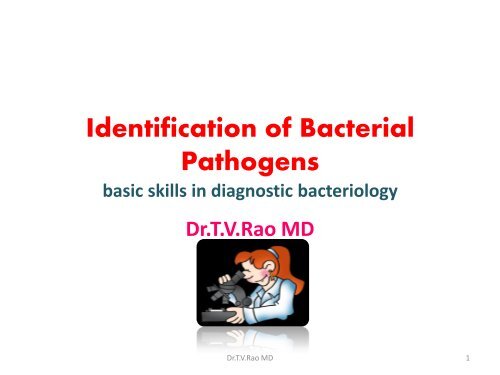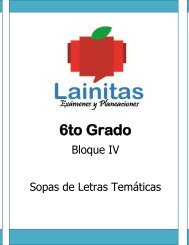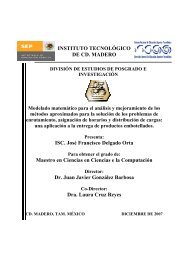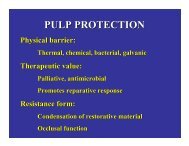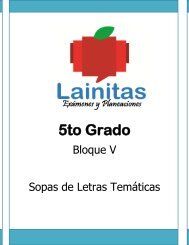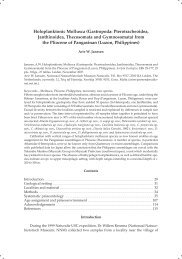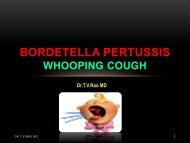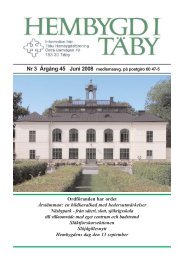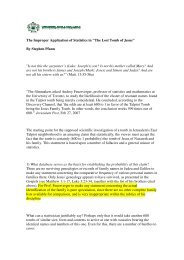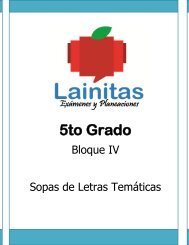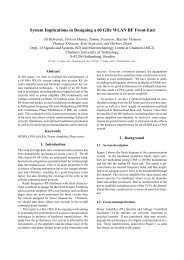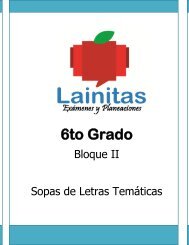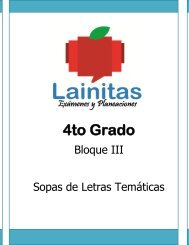Identification of Bacterial Pathogens basic skills in bacteriology
Identification of Bacterial Pathogens basic skills in bacteriology
Identification of Bacterial Pathogens basic skills in bacteriology
Create successful ePaper yourself
Turn your PDF publications into a flip-book with our unique Google optimized e-Paper software.
<strong>Identification</strong> <strong>of</strong> <strong>Bacterial</strong><strong>Pathogens</strong><strong>basic</strong> <strong>skills</strong> <strong>in</strong> diagnostic <strong>bacteriology</strong>Dr.T.V.Rao MDDr.T.V.Rao MD 1
<strong>Identification</strong> <strong>of</strong> Microorganisms• For many students and pr<strong>of</strong>essionals the mostpress<strong>in</strong>g topic <strong>in</strong> microbiology is how to identifyunknown specimens.• Why is this important?• Labs can grow, isolate and identify most rout<strong>in</strong>elyencountered bacteria with<strong>in</strong> 48 hrs <strong>of</strong> sampl<strong>in</strong>g.• The methods microbiologist use fall <strong>in</strong>to threecategories:♣Phenotypic- morphology (micro andmacroscopic)♣Immunological- serological analysis♣Genotypic- genetic techniquesDr.T.V.Rao MD2
Microbe<strong>Identification</strong>Dr.T.V.Rao MD5
Specimen Collection• Successful identification depends on how the specimenis collected, handled and stored.• It is important that general aseptic procedures be used<strong>in</strong>clud<strong>in</strong>g sterile sample conta<strong>in</strong>ers and sampl<strong>in</strong>gmethods to prevent contam<strong>in</strong>ation <strong>of</strong> the specimen.• E.g. Throat and nasopharyngeal swabs should not touchthe cheek, tongue or salvia.• What other precautions must be taken when collect<strong>in</strong>g specimens?• After collection the specimen must be taken promptlyto the lab and stored appropriately (e.g. refrigeration).Dr.T.V.Rao MD6
SpecimenCollectionDr.T.V.Rao MD7
Phenotypic Methods <strong>of</strong> <strong>Identification</strong>• Microbiologists use 5 <strong>basic</strong> techniques to grow,exam<strong>in</strong>e and characterize microorganisms <strong>in</strong>the lab.• They are called the 5 ‘I’s: <strong>in</strong>oculation,<strong>in</strong>cubation, isolation, <strong>in</strong>spection andidentification.• Inoculation: to culture microorganisms a t<strong>in</strong>ysample (<strong>in</strong>oculum) is <strong>in</strong>troduced <strong>in</strong>to medium(<strong>in</strong>oculation).• Isolation <strong>in</strong>volves the separat<strong>in</strong>g one speciesDr.T.V.Rao MDfrom another.8
Phenotypic Methods• Macroscopic morphology are traits that can beaccessed with the naked eye e.g. appearance <strong>of</strong> colony<strong>in</strong>clud<strong>in</strong>g texture, shape, pigment, speed <strong>of</strong> growth andgrowth pattern <strong>in</strong> broth.• Physiology/Biochemical characteristic are traditionalma<strong>in</strong>stay <strong>of</strong> bacterial identification.• These <strong>in</strong>clude enzymes (catalase, oxidase,decarboxylase), fermentation <strong>of</strong> sugars, capacity todigest or metabolize complex polymers and sensitivityto drugs can be used <strong>in</strong> identification.Dr.T.V.Rao MD12
Gm+ve cocci & Gm-ve bacilliDr.T.V.Rao MD17
StreptococcusDr.T.V.Rao MD 18
BacilliDr.T.V.Rao MD 19
Neisseria gonorrhea - Gram sta<strong>in</strong>http://www.cdc.gov/STD/LabGuidel<strong>in</strong>es/default.htmDr.T.V.Rao MD 20
Wound specimen - Gram sta<strong>in</strong>http://www.healthsci.utas.edu.au/hls/teach<strong>in</strong>g/micro/mma.htmlDr.T.V.Rao MD 21
Oral specimen - Gram sta<strong>in</strong>Dr.T.V.Rao MD 22http://www.healthsci.utas.edu.au/hls/teach<strong>in</strong>g/micro/mma.html
Sputum specimen Gram sta<strong>in</strong>—Streptococcus pneumoniaehttp://www.healthsci.utas.edu.au/hls/teach<strong>in</strong>g/micro/mma.htmlDr.T.V.Rao MD 23
Sputum—cystic fibrosis patient, encapsulated gram negative rodshttp://www.healthsci.utas.edu.au/hls/teach<strong>in</strong>g/micro/mma.htmlDr.T.V.Rao MD 24
Sta<strong>in</strong><strong>in</strong>g techniques forMycobacterial spp• Acid-fast sta<strong>in</strong>s– for sta<strong>in</strong><strong>in</strong>g <strong>of</strong> organisms with high degree <strong>of</strong> fatty(mycolic) acids—waxy– render the cells resistant to decolorization: “acid-fast”– Mycobacterium sp., Nocardia sp., Cryptosporidiumsp. are acid-fast– Procedure• Ziehl-Neelsen: heat drives <strong>in</strong> primary sta<strong>in</strong> (carbolfuchs<strong>in</strong>)• K<strong>in</strong>youn: higher conc. <strong>of</strong> phenol does not require heat• Decolorize with acid-alcohol• Countersta<strong>in</strong> with methylene blue or malachite greenDr.T.V.Rao MD 25
1 2 34 5 67Ziehl-Neelsensta<strong>in</strong>Dr.T.V.Rao MD26
How the Acid fast bacteria appearDr.T.V.Rao MD27
A Gram sta<strong>in</strong> (left) <strong>of</strong> the abscess shows th<strong>in</strong>, gram positive rods <strong>in</strong> cha<strong>in</strong>s.An acid fast sta<strong>in</strong> (right) was also positive.http://pathhsw5m54.ucsf.edu/overview/bacteria3.htmlDr.T.V.Rao MD 28
Sputum specimen—Acid fast sta<strong>in</strong>http://www.healthsci.utas.edu.au/hls/teach<strong>in</strong>g/micro/mma.htmlDr.T.V.Rao MD 29
Acid fast sta<strong>in</strong> demonstrat<strong>in</strong>g chord<strong>in</strong>gDr.T.V.Rao MD 30
Fluorochrome AFB Microscopy* More rapid andsensitive* Specificity : same withsufficient expérience* Equipment cost ,bulbs, technicaldemands* for busy labs* External qualityassessment should bedone if this method isperformed Dr.T.V.Rao MD31
Direct Fluorescent Antibodies32
Indirect Fluorescent Antibodies33
Mycobacterium – auram<strong>in</strong>e sta<strong>in</strong>http://www.lung.ca/tb/abouttb/what/causes_tb.htmlDr.T.V.Rao MD 34
Yeast—calc<strong>of</strong>luor whitehttp://www.med.sc.edu:85/mycology/mycology-3.htmDr.T.V.Rao MD 35
Mould—calc<strong>of</strong>luor whiteDr.T.V.Rao MD 36
Influenza virus <strong>in</strong>fected cells, fluorescent antibody sta<strong>in</strong>Dr.T.V.Rao MD 37
Better Use Microscopy• Phase Contrast Microscopy– shift <strong>in</strong> light allows visualization <strong>of</strong> organism; canvisualize viable organisms• Fluorescent Microscopy– certa<strong>in</strong> dyes (fluorochromes) give <strong>of</strong>f light whenexcited (fluorescence)– color <strong>of</strong> light depends on the dye and the filters used– Sta<strong>in</strong><strong>in</strong>g techniques• Fluorochrom<strong>in</strong>g: direct chemical <strong>in</strong>teraction with organism– Acrid<strong>in</strong>e orange: sta<strong>in</strong>s nucleic acid; useful for cell-wall deficientorganisms– Auram<strong>in</strong>e-rhodam<strong>in</strong>e: b<strong>in</strong>d to mycolic acids <strong>in</strong> nearly allMycobacteria– Calc<strong>of</strong>lour white: b<strong>in</strong>ds to chit<strong>in</strong> <strong>in</strong> cell walls <strong>of</strong> fungi• Immun<strong>of</strong>luorescence: fluorochrome is bound to an antibody;can detect/identify specific organismsDr.T.V.Rao MD 38
Culture and isolation <strong>of</strong> bacteria• Pr<strong>in</strong>ciples <strong>of</strong> Cultivation– Nutritional requirements• General concepts– non-fastidious: simple requirements for growth– fastidious: complex, unusual, or uniquerequirements for growth• Phases <strong>of</strong> growth media– solid agar; boil to dissolve, solidifies at50ºC– liquid, brothDr.T.V.Rao MD 39
• Media classifications and functions–Enrichment• used to enhance growth <strong>of</strong> specificorganisms–Supportive• support growth <strong>of</strong> most non-fastidiousorganisms–Selective• conta<strong>in</strong>s agents that <strong>in</strong>hibit the growth <strong>of</strong> allagents except that be<strong>in</strong>g sought (dyes, bilesalts, alcohols, acids, antibiotics)–Differential• conta<strong>in</strong>s factor(s) that allow certa<strong>in</strong>organisms to exhibit different metaboliccharacteristicsDr.T.V.Rao MD 40
Accord<strong>in</strong>g to Use• Enriched Medium –broth or solid, conta<strong>in</strong>srich supply <strong>of</strong> specialnutrients that promotesgrowth <strong>of</strong> a particularorganism while notpromot<strong>in</strong>g growth <strong>of</strong>other microbes thatmay be present (e.g BAP& chocolate agar)Dr.T.V.Rao MD 41
• Types <strong>of</strong> artificial media– Bra<strong>in</strong>-heart <strong>in</strong>fusion• nutritionally rich supportive media used <strong>in</strong> broths,blood culture systems and susceptibility test<strong>in</strong>g– Sheep blood agar• supportive media conta<strong>in</strong><strong>in</strong>g 5% sheep blood forvisualization <strong>of</strong> hemolysis– Chocolate agar• same as sheep blood agar except blood has been“chocolatized” RBCs lysed by heat<strong>in</strong>g; releases X(hem<strong>in</strong>) and V (NAD) factors for Neisseria andHaemophilus– MacConkey agar• selective for Gram-negative rods (GNRs)because <strong>of</strong> crystal violet and bile salts; differentialdue to lactose, fermenters lower pH chang<strong>in</strong>gneutral red <strong>in</strong>dicator p<strong>in</strong>k/redDr.T.V.Rao MD 42
Accord<strong>in</strong>g to Use• Selective Medium -conta<strong>in</strong>s <strong>in</strong>hibitorsthat discourage thegrowth <strong>of</strong> certa<strong>in</strong>organisms &enhances thegrowth <strong>of</strong> themicrobe sought(e.g. SSA, MannitolSalt Agar)Dr.T.V.Rao MD 43
Accord<strong>in</strong>g to Use• Differential Medium -conta<strong>in</strong>s dyes, <strong>in</strong>dicatorsor other constituentsthat give colonies <strong>of</strong>particular organismsdist<strong>in</strong>ctive and easilyrecognizablecharacteristics (e.g.McConkey Agar)Dr.T.V.Rao MD 44
Hemolysis a guid<strong>in</strong>g factorDr.T.V.Rao MD 45
Hemolysis a guid<strong>in</strong>g factorDr.T.V.Rao MD 46
Enriched MediaChocolate agar, a mediumthat gets brown fromheated blood. Used forisolation <strong>of</strong> N. gonorrhea.Blood agar plate withbacteria from human throat.This media differentiatesamong different colonies byappearanceDr.T.V.Rao MD47
Test<strong>in</strong>g for Bacitrac<strong>in</strong> and Optoch<strong>in</strong>SensitivityDr.T.V.Rao MD 48
Dr.T.V.Rao MD 49
Mac Conkey Agar a M<strong>in</strong>imaldifferentiat<strong>in</strong>g MediumDr.T.V.Rao MD 50
MacConkey AgarDr.T.V.Rao MD 51
General vs Selective MediaDr.T.V.Rao MD52
Differential Media• Differential media growseveral types <strong>of</strong>organisms and displayvisible differencesamong organisms.• Differences may showup as colony size, mediacolour, gas bubbleformation andprecipitate formation.Dr.T.V.Rao MD53
Salmonella-Shigella AgarDr.T.V.Rao MD 54
Dr.T.V.Rao MD 55
• Types <strong>of</strong> artificial media– Hektoen enteric agar• conta<strong>in</strong>s bile salts and dyes(bromothymol blue and acid fuchs<strong>in</strong>) to<strong>in</strong>hibit non-pathogenic GNRs; nonpathogens ferment lactose chang<strong>in</strong>gBTB to orange; pathogens Salmonellaand Shigella are clear; ferric ammoniumcitrate detects H 2 S production <strong>of</strong>Salmonella (black colonies)– Columbia colist<strong>in</strong>-nalidixic acid (CNA)agar• Columbia agar base, sheep blood,colist<strong>in</strong> and nalidixic acid; selectiveisolation <strong>of</strong> gram-positive cocciDr.T.V.Rao MD 56
• Types <strong>of</strong> artificial media– Hektoen enteric agar• conta<strong>in</strong>s bile salts and dyes (bromothymolblue and acid fuchs<strong>in</strong>) to <strong>in</strong>hibit nonpathogenicGNRs; non pathogens fermentlactose chang<strong>in</strong>g BTB to orange; pathogensSalmonella and Shigella are clear; ferricammonium citrate detects H 2 S production <strong>of</strong>Salmonella (black colonies)– Columbia colist<strong>in</strong>-nalidixic acid (CNA)agar• Columbia agar base, sheep blood, colist<strong>in</strong>and nalidixic acid; selective isolation <strong>of</strong> grampositivecocciDr.T.V.Rao MD 57
Types <strong>of</strong> artificial media– Thayer-Mart<strong>in</strong> agar• CAP with antibiotics (colist<strong>in</strong> <strong>in</strong>hibits gramneg, vancomyc<strong>in</strong> <strong>in</strong>hibits gram pos,nystat<strong>in</strong> <strong>in</strong>hibits yeast); for N.gonorrhoeae and N. men<strong>in</strong>gitidis; Mart<strong>in</strong>-Lewis has similar function but differentantibiotics• Preparation <strong>of</strong> artificial media– Sterilization• autoclave: pressurized steam at 121ºC for15-30 m<strong>in</strong>.Dr.T.V.Rao MD 58
• Environmental requirements– Oxygen and Carbon dioxide availability• aerobic: room air• facultative: aerobic or anaerobic• microaerophilic: reduced oxygen tension• anaerobic– strict or aerotolerant• capnophilic: <strong>in</strong>creased C0 2 (5-10%)– Temperature• 35-37ºC• 30ºC• cold• 42ºCDr.T.V.Rao MD 59
• <strong>Bacterial</strong> Cultivation– Isolation <strong>of</strong> bacteria from specimens• streak<strong>in</strong>g for isolation• streak<strong>in</strong>g for quantitation– Evaluation <strong>of</strong> colony morphologies• Type <strong>of</strong> media support<strong>in</strong>g growth• Relative quantities <strong>of</strong> each colony type• Colony characteristics– colony form: p<strong>in</strong>po<strong>in</strong>t, circular, filamentous,irregular– colony elevation: flat, raised, convex– colony marg<strong>in</strong>: smooth, irregular• Gram sta<strong>in</strong> and subcultures– sterile loop, isolated coloniesDr.T.V.Rao MD 60
http://science.nhmccd.edu/biol/wellmeyer/media/media.htmDr.T.V.Rao MD 61
Chocolate agarUn<strong>in</strong>oculatedHaemophilushttp://www.hardydiagnostics.com/catalog2/hugo/ChocolateAgar.htmDr.T.V.Rao MD 62
MacConkey agarhttp://science.nhmccd.edu/biol/wellmeyer/media/media.htmDr.T.V.Rao MD 63
Hektoen agarhttp://medic.med.uth.tmc.edu/path/hekto.htmDr.T.V.Rao MD 64
• Nutritional requirements and metaboliccapabilities– S<strong>in</strong>gle enzyme tests• Catalase: H 2 O 2 + catalase = O 2 and H 2 0;differentiates Staphylococcus v. Streptococcus,Listeria and Corynebacterium v. other non sporeform<strong>in</strong>g gram-positive bacilli• Oxidase: detection <strong>of</strong> cytochrome oxidase thatparticipates <strong>in</strong> nitrate metabolism; Pseudomonas,Aeromonas, Neisseria• Indole: tryptophanase degrades tryptophan <strong>in</strong>topyruvic acid, ammonia, and <strong>in</strong>dole; <strong>in</strong>dole isdetected by aldehyde <strong>in</strong>dicator; presumptive id forE. coli• Urease: hydrolyzes urea <strong>in</strong>to ammonia, water andCO 2 ; <strong>in</strong>crease pH changes causes bright p<strong>in</strong>k color<strong>of</strong> <strong>in</strong>dicator• PYR: hydrolysis <strong>of</strong> PYR, <strong>in</strong>dicator turns p<strong>in</strong>k; GroupA Strep and enterococci are +Dr.T.V.Rao MD 65
Biochemical Tests• The microbe is cultured <strong>in</strong> a media with a specialsubstrate and tested for an end product.• Prom<strong>in</strong>ent biochemical tests <strong>in</strong>clude carbohydratefermentation, acid or gas production and thehydrolysis <strong>of</strong> gelat<strong>in</strong> or starch.• Many <strong>of</strong> these test <strong>in</strong> rapid m<strong>in</strong>iaturized system thatcan detect for 23 characteristics <strong>in</strong> small cups calledRapid test.• The <strong>in</strong>fo from the rapid test are <strong>in</strong>put <strong>in</strong>to a computerto help <strong>in</strong> identification <strong>of</strong> the organisms.Dr.T.V.Rao MD66
CarbohydrateFermentation . This medium showfermentation (acidproduction) and gasformation. The small Durham tube forcollect<strong>in</strong>g gas bubbles. Left- right:Un<strong>in</strong>oculated negativecontrolCentre, positive for acid(yellow) and gas (openspace).Growth but no gas oracid.Dr.T.V.Rao MD67
Methyl Red Test• This is a qualitativetest for acidproduction.• The bacteria is grown<strong>in</strong> MR-VP broth.• After addition <strong>of</strong>several drops <strong>of</strong>methyl red solution abright red colour ispositive and yelloworangenegative.Dr.T.V.Rao MD68
Nitrate Reduction ♫After 24-48 hrs <strong>of</strong><strong>in</strong>cubation, nitratereagents are added.♫Left to right:♫Gas formation (positivefor nitrate reduction).♫positive for nitratereduction to nitrite (red colour).♫Negative controlDr.T.V.Rao MD69
Biochemical Tests• Other biochemical tests <strong>of</strong> <strong>in</strong>terest <strong>in</strong>clude:‣H 2 S production‣Indole test‣Oxidase test‣Oxidation fermentation‣Phenylalan<strong>in</strong>e deam<strong>in</strong>ase test‣Antibiotic susceptibility tests• Pr<strong>in</strong>ciple, procedure, most common use.Dr.T.V.Rao MD70
Dr.T.V.Rao MD 71
Dr.T.V.Rao MD 72
Coagulase TestDr.T.V.Rao MD 73
–Tests for presence <strong>of</strong>metabolic pathways• Oxidation and fermentation: oxidation<strong>of</strong> glucose requires oxygen,fermentation does not; pH decreasescaus<strong>in</strong>g yellow color• Am<strong>in</strong>o acid degradation: detection <strong>of</strong>am<strong>in</strong>o acid decarboxylase enzymesDr.T.V.Rao MD 74
O-F glucose mediahttp://academic.mwsc.edu/jcbaker/bio390sec01/bio390_laboratory_study_images.htmDr.T.V.Rao MD 75
Chromagar orientationuses colour-formation todist<strong>in</strong>guish at least 7common ur<strong>in</strong>arypathogens.DifferentialMediaChromagarThis allow for rapididentification andtreatment. The bacteria werestreaked as to spell theirnames.Dr.T.V.Rao MD76
• Pr<strong>in</strong>ciples <strong>of</strong> Phenotype-based IDschemes– Selection and <strong>in</strong>oculation <strong>of</strong> ID test battery• Type <strong>of</strong> bacteria to be identified• Cl<strong>in</strong>ical significance <strong>of</strong> isolate• Availability <strong>of</strong> reliable test<strong>in</strong>g methods– Incubation for substrate utilization• Conventional ID• Rapid ID– Detection <strong>of</strong> metabolic activity• Colorimetry: pH change <strong>of</strong> <strong>in</strong>dicators• Fluorescence: release <strong>of</strong> fluorophore from substrate orchanges <strong>in</strong> fluorescence due to pH changes• Turbiditiy: growth or no-growth– Analysis <strong>of</strong> metabolic pr<strong>of</strong>iles• ID databases• Use <strong>of</strong> databases to ID unknowns– Confidence <strong>in</strong> IDDr.T.V.Rao MD 77
Rapid Tests• Rapid test: a biochemical system for the identification<strong>of</strong> Enterobacteriaceae and other Gram –ve bacteria.• It consist <strong>of</strong> plastic strips with 20 μl <strong>of</strong> dehydratedbiochemical substrates used to detect biochemicalcharacteristics.• The biochemical substrates are <strong>in</strong>oculated with purecultures and suspended <strong>in</strong> physiological sal<strong>in</strong>e.• After 5 hrs-overnight the 20 tests are converted to 7-9digital pr<strong>of</strong>ile.Dr.T.V.Rao MD78
Rapid TestspositivenegativeONPG (β galactosidase); ADH (arg<strong>in</strong><strong>in</strong>e dihydrolase); LDC (lys<strong>in</strong>e decarboxylase); ODC(ornith<strong>in</strong>e decarboxylase); CIT (citrate utilization); H 2 S (hydrogen disulphide production); URE(urease); TDA ( tryptophan deam<strong>in</strong>ase); IND (<strong>in</strong>dole production); VP (Voges Proskauer test foraceto<strong>in</strong>); GEL ( gelat<strong>in</strong> liquefaction); the fermentation <strong>of</strong> glucose (GLU), mannitol (MAN),<strong>in</strong>ositol (INO), sorbitol (SOR), rhamnose (RHA), sucrose (SAC); Melibiose (MEL), amygdal<strong>in</strong>(AMY), and arab<strong>in</strong>ose (ARA); and OXI (oxidase).Dr.T.V.Rao MD79
Bacteriophage Typ<strong>in</strong>g• What are bacteriophages?• Bacteriophage typ<strong>in</strong>g is based on the specificity <strong>of</strong>phage surface receptor for the cell surface receptor.• Only those phages that can attach to the surfacereceptors can cause lysis.• The procedure <strong>in</strong>volves:• A plate is heavily <strong>in</strong>oculated so that there is noun<strong>in</strong>oculated areas.• The plate is marked <strong>of</strong>f <strong>in</strong> squares (15-20 mm) andeach square <strong>in</strong>oculated with a drop <strong>of</strong> suspension fordifferent phages.Dr.T.V.Rao MD80
Heavily Inoculated PlateDr.T.V.Rao MD81
Bacteriophage Typ<strong>in</strong>g• The plate is <strong>in</strong>cubated for 24 hrs then observedfor plaques.• The phage type is reported as a specific genusand species followed by the types that can <strong>in</strong>fectthe bacterium.• E.g. 10/16/24 means that the bacteria issensitive to phages 10, 16 and 24.• Phage ty<strong>in</strong>g rema<strong>in</strong> a tool for research andreference labs.Dr.T.V.Rao MD82
Uncultivable Organisms• Environmentalresearchers estimatethat < 1% <strong>of</strong>microorganisms areculturable andtherefore it is notpossible to usephenotypic methods <strong>of</strong>identification.• These microorganismsare called viablenonculturable (VNC).Dr.T.V.Rao MD83
Flow Cytometry• Classical techniques are not successful <strong>in</strong> identification<strong>of</strong> those microorganisms that cannot be cultured.• What do is the name <strong>of</strong> microorganisms that cannot be cultured?• Flow cytometry allows s<strong>in</strong>gle or multiplemicroorganisms detection an easy, reliable and fast way.• Inflow cytometry microorganisms are identified on thebasis <strong>of</strong> the cytometry parameters or by means <strong>of</strong>certa<strong>in</strong> dyes called fluorochromes that can be used<strong>in</strong>dependently or bound to specific antibodies.Dr.T.V.Rao MD84
Flow Cytometry• The cytometer forces a suspension <strong>of</strong>cells through a laser beam and measuresthe light they scatter or the fluorescencethe cell emits as they pass through thebeam.• The cytometer also can measure thecell’s shape, size and the content <strong>of</strong> theDNA or RNA.Dr.T.V.Rao MD85
Recent Advances <strong>in</strong> Flowcytometry• Flow cytometry (FCM) allows s<strong>in</strong>gle- or multiplemicrobedetection <strong>in</strong> cl<strong>in</strong>ical samples <strong>in</strong> an easy,reliable, and fast way. Microbes can be identifiedon the basis <strong>of</strong> their peculiar cytometryparameters or by means <strong>of</strong> certa<strong>in</strong> fluorochromesthat can be used either <strong>in</strong>dependently or boundto specific antibodies or oligonucleotides. FCMhas permitted the development <strong>of</strong> quantitativeprocedures to assess antimicrobial susceptibilityand drug cytotoxicity <strong>in</strong> a rapid, accurate, andhighly reproducible wayDr.T.V.Rao MD 86
Immunological Methods• Immunological methods <strong>in</strong>volve the <strong>in</strong>teraction<strong>of</strong> a microbial antigen with an antibody(produced by the host immune system).• Test<strong>in</strong>g for microbial antigen or the production<strong>of</strong> antibodies is <strong>of</strong>ten easier than test for themicrobe itself.• Lab kits based on this technique is available forthe identification <strong>of</strong> many microorganisms.Dr.T.V.Rao MD87
Pr<strong>in</strong>ciples <strong>of</strong> Serologic Test Methods– Methods for antibody detection• Direct whole pathogen agglut<strong>in</strong>ation assays– pos patient sera causes organism to clump• Particle agglut<strong>in</strong>ation tests– latex beads or RBCs coated with Ag• Flocculation tests– RPR – precipitation <strong>of</strong> soluble Ag with Ab» charcoal particles coated with cardiolip<strong>in</strong>-lecith<strong>in</strong>b<strong>in</strong>ds reag<strong>in</strong>• ELISAs• IFAs– organism/antigen on slides; patient Ab detected withfluorescent secondary Ab• Western blotsDr.T.V.Rao MD 88
API strips – bioMerieuxDr.T.V.Rao MD 89
Commercial ID systems– Advantages andexamples <strong>of</strong>commercialsystems• ARIS (Trek)• MicroScan (Dade-Behr<strong>in</strong>g/Seimens)• Phoenix (Becton-Dick<strong>in</strong>son)• Vitek(bioMérieux)Dr.T.V.Rao MD 90
Immunochemical methods for ID• Pr<strong>in</strong>ciples <strong>of</strong> immunochemical methods– Particle agglut<strong>in</strong>ation• Latex agglut<strong>in</strong>ation– Immun<strong>of</strong>loresecent assays• Direct immun<strong>of</strong>luorescence assay (DFA)• Indirect immun<strong>of</strong>luorescence assay (IFA)• Enzyme immunoassays– Solid-phase immunoassays• Membrane bound immunoassays• Immunochromatographic assays– Optical immunoassaysDr.T.V.Rao MD 91
Serologic methods for diagnosis• Features <strong>of</strong> the Immune Response– Characteristics <strong>of</strong> antibodies• Features <strong>of</strong> immune response useful <strong>in</strong> diagnostictest<strong>in</strong>g– Acute v. anamnestic response– IgM v. IgG– IgM can’t cross placenta– immunocompetent v. immunocompromised• Interpretation <strong>of</strong> serologic tests– s<strong>in</strong>gle v. paired sera; rare pathogen– 4-fold rise <strong>in</strong> titer v. qualitative test<strong>in</strong>g– cross reactivity (herpes viruses, heterophile Abs,pregnancy)Dr.T.V.Rao MD 92
Pr<strong>in</strong>ciples <strong>of</strong> Serologic Test Methods– Methods for antibody detection• Direct whole pathogen agglut<strong>in</strong>ation assays– pos patient sera causes organism to clump• Particle agglut<strong>in</strong>ation tests– latex beads or RBCs coated with Ag• Flocculation tests– RPR – precipitation <strong>of</strong> soluble Ag with Ab» charcoal particles coated with cardiolip<strong>in</strong>-lecith<strong>in</strong>b<strong>in</strong>ds reag<strong>in</strong>• ELISAs• IFAs– organism/antigen on slides; patient Ab detected withfluorescent secondary Ab• Western blotsDr.T.V.Rao MD 93
Genotypic methods• Genotypic methods <strong>of</strong> microbe identification<strong>in</strong>clude the use <strong>of</strong> :Nucleic acid probesPCR (RT-PCR, RAPD-PCR)Nucleic acid sequence analysisrRNA analysisRFLPPlasmid f<strong>in</strong>gerpr<strong>in</strong>t<strong>in</strong>g.94
Genotypic Methods• Genotypic methods <strong>in</strong>volve exam<strong>in</strong><strong>in</strong>g thegenetic material <strong>of</strong> the organisms and hasrevolutionized bacterial identification andclassification.• Genotypic methods <strong>in</strong>clude PCR (RT-PCR, RAPD-PCR),use <strong>of</strong> nucleic acid probes, RFLP andplasmid f<strong>in</strong>gerpr<strong>in</strong>t<strong>in</strong>g.• Increas<strong>in</strong>gly genotypic techniques are becom<strong>in</strong>gthe sole means <strong>of</strong> identify<strong>in</strong>g manymicroorganisms because <strong>of</strong> its speed andaccuracy.Dr.T.V.Rao MD95
Real Time PCR and RT-PCR• Currently many PCR tests employ real time PCR.• This <strong>in</strong>volves the use <strong>of</strong> fluorescent primers.• The PCR mach<strong>in</strong>e monitors the <strong>in</strong>corporation <strong>of</strong> the primers anddisplay an amplification plot which can be viewed cont<strong>in</strong>uouslythru the PCR cycle.• Real time PCR yields immediate results.• Another application <strong>of</strong> PCR is RT-PCR (reverse trancriptase PCR).• Dur<strong>in</strong>g RT-PCR an RNA template is used to generate cDNA andfrom this dsDNA is generated.• The enzyme used is reverse transciptase.• RT-PCR is used to detect for HIV and to monitor the progress <strong>of</strong>the disease.96
RAPD-PCR• Random amplified polymorphic DNA PCR uses arandom primer (10-mer) to generate a DNA pr<strong>of</strong>ile.• What are random primers?• The primer anneals to several places on the DNAtemplate and generate a DNA pr<strong>of</strong>ile which is used formicrobe identification.• RAPD has many advantages:Pure DNA is not neededLess labour <strong>in</strong>tensive than RFLP.There is not need for prior DNA sequence data.• RAPD has been used to f<strong>in</strong>gerpr<strong>in</strong>t the outbreak <strong>of</strong>Listeria monocytogenes from milk.97
Plasmid f<strong>in</strong>gerpr<strong>in</strong>t<strong>in</strong>g• The procedure <strong>in</strong>volves:• The bacterial stra<strong>in</strong>s aregrown, the cells lysed andharvested.• The plasmids are separatedby agarose gelelectrophoresis• The gels are sta<strong>in</strong>ed withEtBr and the plasmidslocated and compared.98
Computer and Bacteria <strong>Identification</strong>• Computers improvethe efficiency <strong>of</strong> thelab operations and<strong>in</strong>crease the speedand clarity with whichresults can bereported.• Computers are alsoimportant for theresult entry, analysisand preparation.99
• Programme created byDr.T.V.Rao MD for MedicalMicrobiologists <strong>in</strong> Develop<strong>in</strong>gworld• Email• doctortvrao@gmail.comDr.T.V.Rao MD 100


